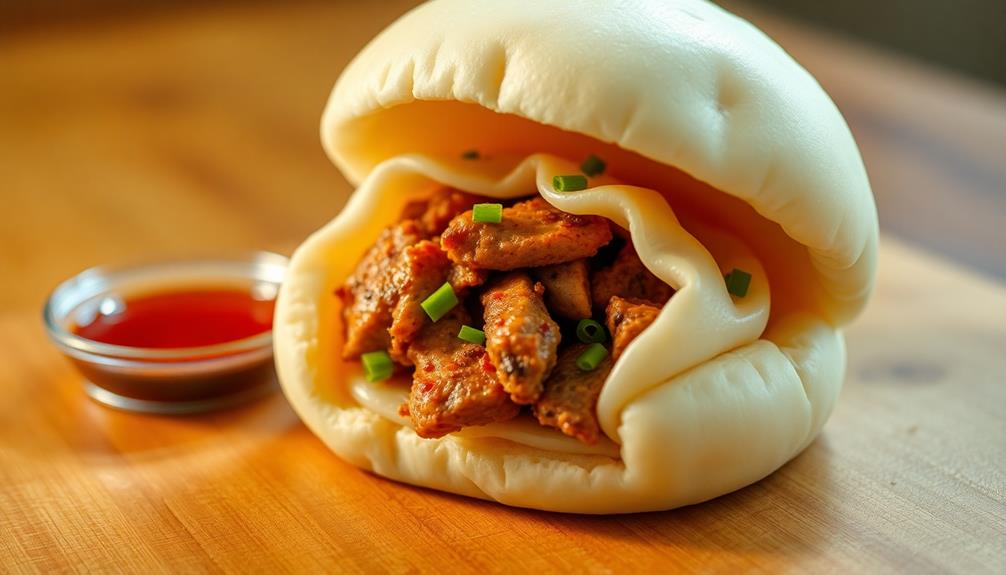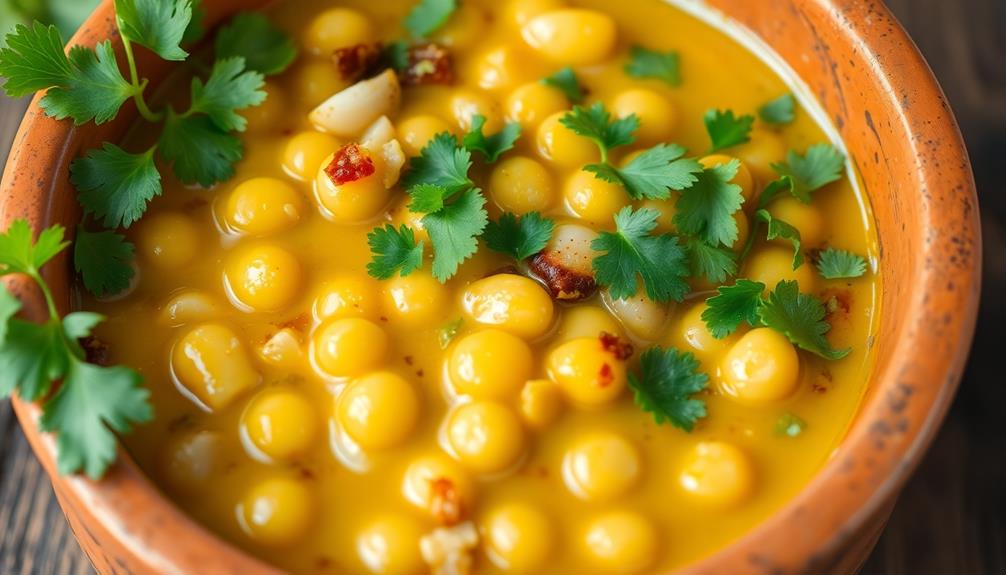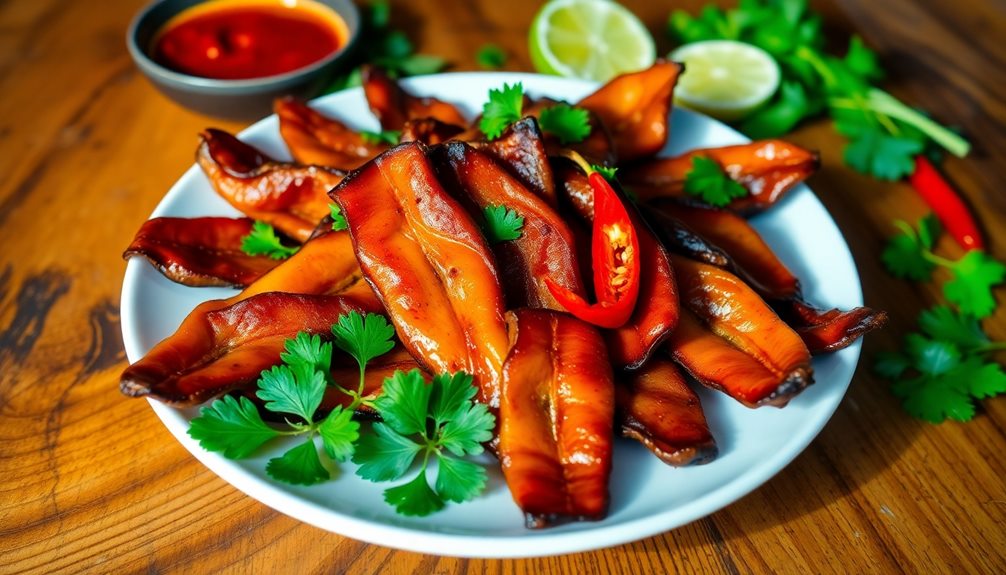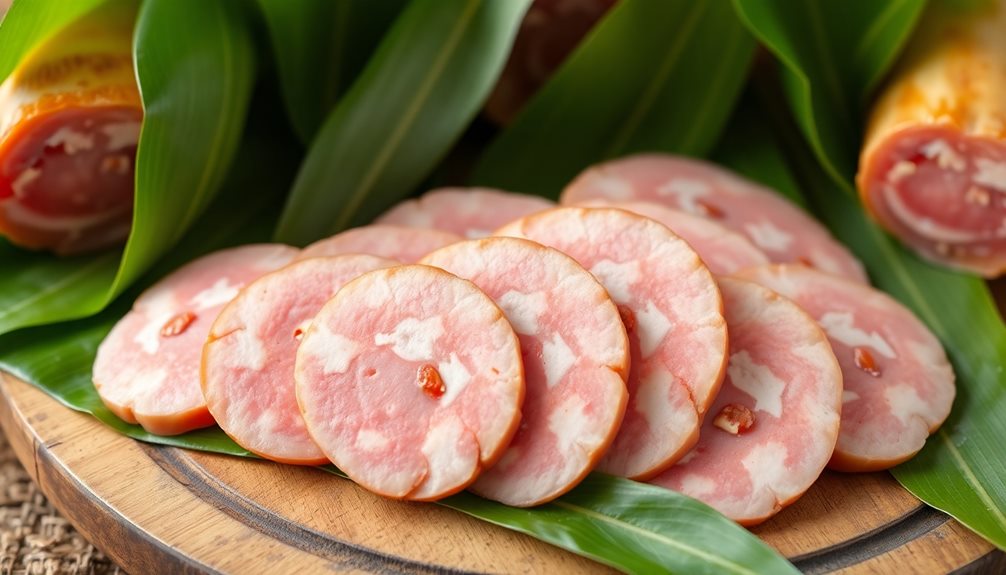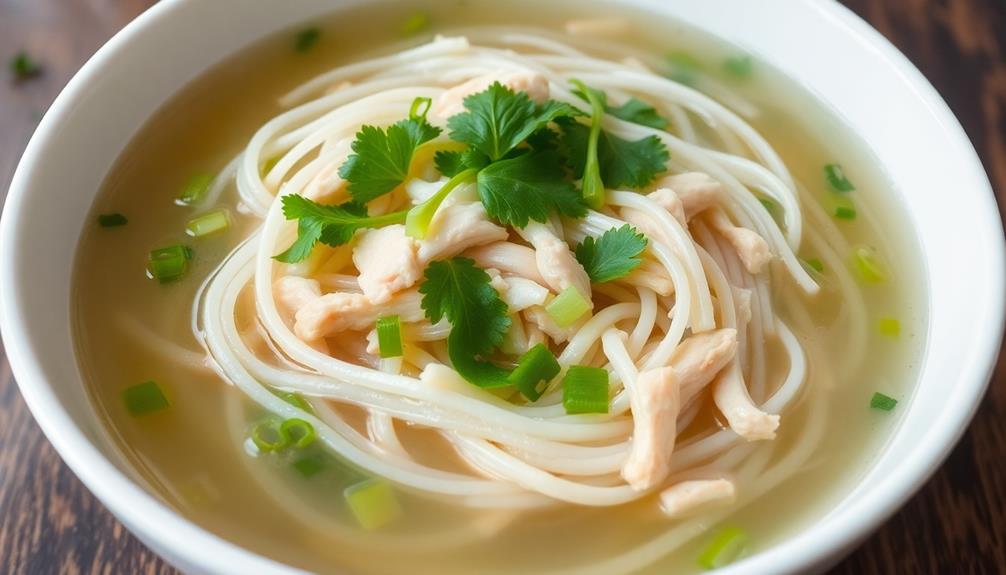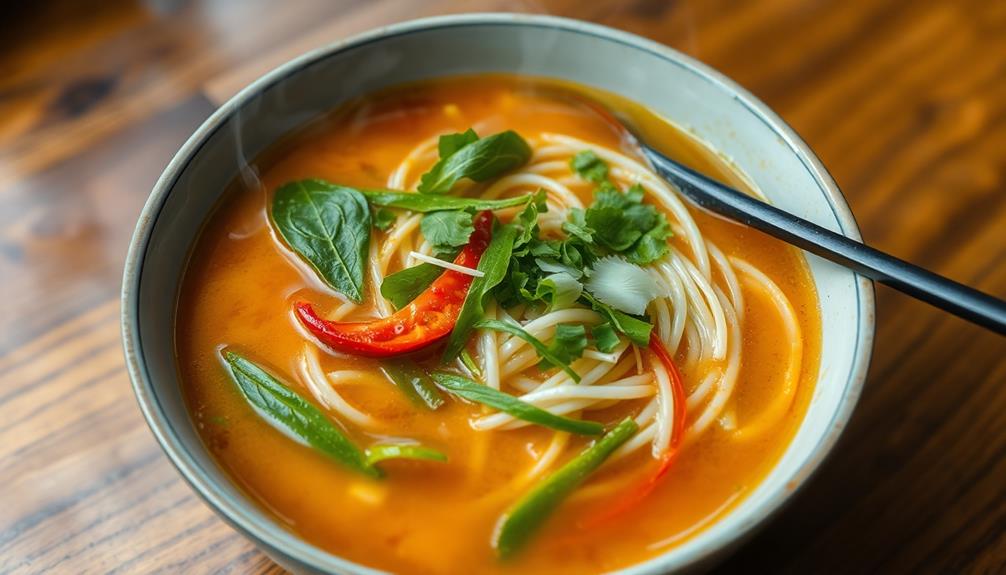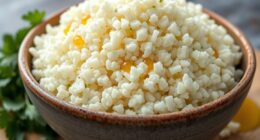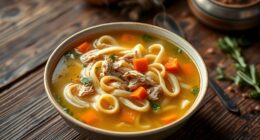Take a trip to Vietnam through the irresistible aroma of freshly steamed banh bao! These soft, pillowy buns are filled with a savory mix of ground pork, mushrooms, and hard-boiled eggs – a true delight for your taste buds. Banh bao's origins trace back to Cantonese immigrants, but over generations, it's evolved into an iconic part of Vietnamese culture. Whether enjoyed as a snack or during a family gathering, these buns represent hospitality and the vibrant spirit of Vietnam. The satisfying crunch and flavor explosion in every bite will have you hooked – and you'll soon discover there's more to explore in this beloved Vietnamese delicacy.
Key Takeaways
- Banh bao is a traditional Vietnamese steamed bun filled with a classic combination of ground pork, mushrooms, and hard-boiled eggs.
- The dish originated from Cantonese cuisine and evolved over generations, becoming an iconic part of Vietnamese street food culture.
- Banh bao is known for its fluffy, pillowy exterior and savory, crunchy filling that provides a satisfying flavor explosion.
- The recipe requires careful preparation of the dough and selection of high-quality ingredients to achieve the perfect texture and taste.
- Banh bao can be enjoyed in both traditional and modern variations, showcasing the versatility and adaptability of this beloved Vietnamese comfort food.
History
Centuries ago, the humble banh bao emerged as a beloved food staple in Vietnam. This delightful steamed bun, filled with savory pork, boiled eggs, and aromatic spices, has been a cherished part of Vietnamese cuisine for generations.
Originating from the Cantonese word "bao," meaning "bread" or "bun," banh bao was likely influenced by the culinary traditions of Chinese immigrants who settled in Vietnam. Over time, Vietnamese cooks put their own spin on the recipe, infusing it with local flavors and ingredients to create the unique and mouthwatering dish we know today.
Whether enjoyed as a quick snack or a satisfying meal, banh bao has become a comforting and iconic part of Vietnamese culture. Its soft, fluffy exterior and flavorful interior make it a true delight for the senses, capturing the rich history and vibrant spirit of this amazing country.
Recipe
Banh Bao is a classic Vietnamese steamed bun filled with a savory mixture of ground pork, mushrooms, and hard-boiled eggs. The soft, pillowy exterior and the flavorful filling make it a beloved comfort food in Vietnamese cuisine. Banh Bao is often enjoyed as a light meal or snack, and its versatility allows for it to be paired with a variety of dipping sauces or enjoyed on its own. Its popularity has even inspired variations, such as a sweet version filled with custard or sweetened mung bean paste. Some people even use the bun cha recipe to create a different kind of filling for Banh Bao, making it a truly customizable and beloved dish in Vietnamese culture.
The process of making Banh Bao may seem daunting, but with a bit of patience and attention to detail, you can create these delightful buns at home. The key is to master the dough, which should be light, fluffy, and just the right level of chewiness.
- All-purpose flour
- Granulated sugar
- Salt
- Warm water
- Vegetable oil
- Ground pork
- Chinese or shiitake mushrooms, finely chopped
- Hard-boiled eggs, quartered
- Soy sauce
- Fish sauce
- White pepper
To make the Banh Bao, start by preparing the dough. In a large bowl, combine the flour, sugar, and salt. Gradually add the warm water and vegetable oil, and knead the mixture until it forms a smooth, elastic dough. Cover the dough and let it rest for at least 30 minutes.
While the dough is resting, prepare the filling. In a skillet, cook the ground pork until browned and crumbly. Add the chopped mushrooms and sauté until softened. Season the mixture with soy sauce, fish sauce, and white pepper to taste.
To assemble the Banh Bao, divide the dough into equal portions and roll each one into a small, round wrapper. Place a spoonful of the pork and mushroom filling in the center, then top with a quarter of a hard-boiled egg. Gather the edges of the wrapper and gently pleat and pinch them together to create a bun shape.
Steam the Banh Bao in a steamer basket for about 15-20 minutes, or until the dough is cooked through and the filling is piping hot. Serve the Banh Bao warm, and enjoy the perfect balance of tender, savory, and comforting flavors.
Remember to keep the steamer basket covered while cooking to ensure the buns steam properly. Additionally, you can experiment with different fillings, such as chicken, shrimp, or even vegetarian options, to suit your personal preferences.
Cooking Steps
Alright, let's knead that dough until it's smooth and elastic!
Once it's ready, divide it into equal portions.
Now, it's time to fill those buns and get 'em steaming for 15 minutes.
Can't wait to see those fluffy, delicious banh bao come to life!
Step 1. Knead Dough Until Smooth and Elastic

Having thoroughly mixed the ingredients, begin kneading the dough on a lightly floured surface. Push the heel of your hand into the dough, then fold it over and push again. Keep repeating this motion, turning the dough as you go.
You'll feel the dough become smoother and more elastic under your hands. This kneading action develops the gluten, which gives the buns their chewy texture.
Knead for about 10 minutes, until the dough is silky and stretches without tearing. If it starts to stick, add a sprinkle of flour. You'll know it's ready when you can poke the dough and it springs back.
Time to let it rest! Cover the dough and set it aside for 30 minutes. This resting period allows the gluten to relax, making the dough easier to shape.
Now you're one step closer to fluffy, pillowy-soft buns!
Step 2. Divide Dough Into Equal Portions
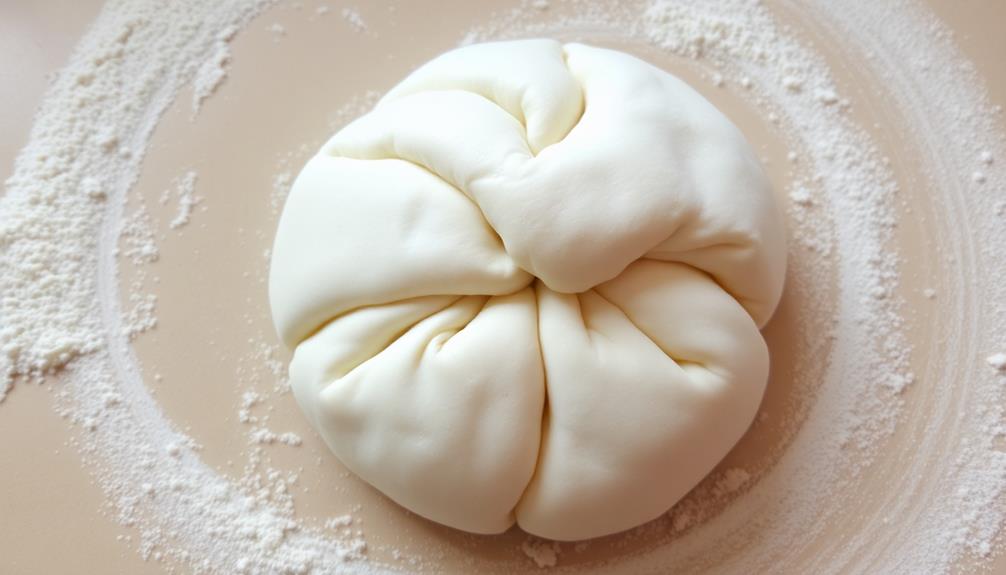
After the dough has rested, it's time to divide it into equal portions. This is an important step, as you want each bun to be the same size so they cook evenly.
Grab the dough and give it a few gentle kneads to reactivate the yeast. Then, use a sharp knife or a bench scraper to cut the dough into 12 equal pieces. Work slowly and carefully – you don't want to deflate all that lovely air you've incorporated!
Roll each piece into a smooth ball, using the palms of your hands to gently cup and shape the dough. Line them up on a lightly floured surface, making sure they're spaced apart so they've room to expand during steaming.
Give the dough balls a quick cover with a damp towel to prevent them from drying out. Now you're ready for the next step – filling the buns! Get excited, because the best part is about to begin.
Step 3. Fill the Buns
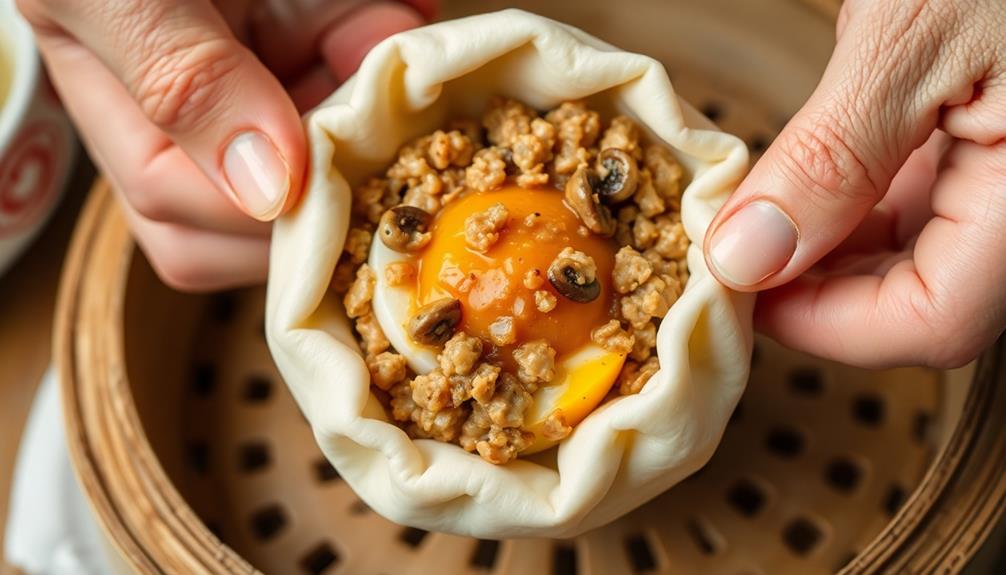
With the dough divided into equal portions, it's time to fill the buns! Grab a piece of dough and gently flatten it into a circle using your hands.
Place a spoonful of the savory pork filling into the center. Carefully fold the dough over the filling, pinching and pleating the edges to seal in the deliciousness.
Repeat this process with the remaining dough and filling, creating a batch of plump, stuffed buns.
Once filled, arrange the buns in a steamer, leaving a little space between each one. Cover and steam for about 15 minutes, until the buns are soft, fluffy, and the filling is hot and cooked through.
Mmm, can you just imagine the aroma of these freshly steamed banh bao? The soft, pillowy exterior gives way to the flavorful pork and veggie filling inside.
Serve these buns warm, straight from the steamer, and enjoy every amazing bite!
Step 4. Place Buns in Steamer
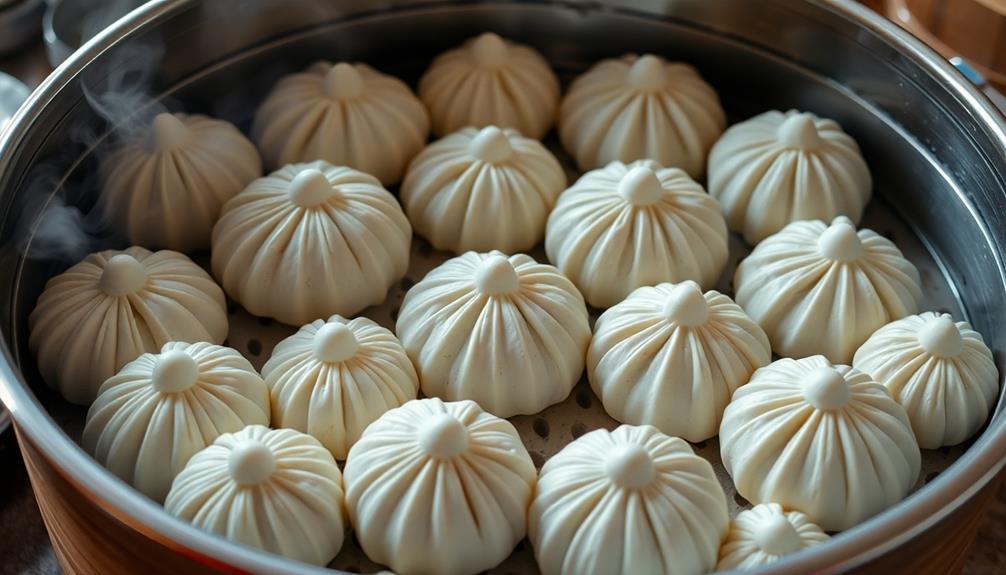
Once the buns are filled, arrange them in a steamer, leaving a little space between each one. You don't want them to stick together!
Gently place the steamer on the stove over medium-high heat. As the water starts to boil, the steam will rise and cook the buns to fluffy perfection.
You'll know they're done when the buns have puffed up and the dough is cooked through. It should only take about 15-20 minutes. Keep an eye on the water level and add more if it starts to run low.
The buns should be nice and soft, with a delightful aroma wafting through the kitchen.
Carefully remove the steamer from the heat and open the lid. Use tongs to transfer the hot buns to a serving plate. They're ready to enjoy!
The aromatic filling, coupled with the pillowy-soft exterior, makes for a truly delectable treat. Grab one while it's hot and savor every bite.
Step 5. Steam Buns for 15 Minutes
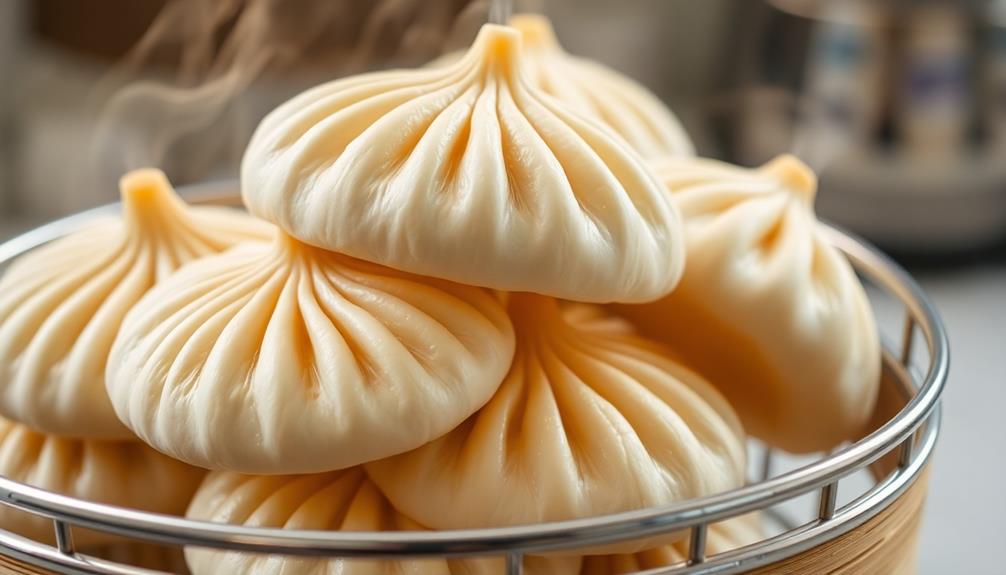
To steam the buns, place the filled buns in the steamer, leaving a little space between each one.
You'll want to make sure they don't touch, so they can puff up nicely.
Now, cover the steamer with the lid and let the buns steam for 15 minutes.
You'll know they're ready when they've turned a lovely, golden-brown color.
The aroma will fill the air, making your mouth water in anticipation!
As the buns steam, the dough will become light and fluffy, while the savory filling will heat through.
Be careful when you remove the lid – the steam will be hot!
Using tongs, gently transfer the buns to a plate.
They're best enjoyed warm, so don't let them sit too long.
Grab a bun, take a bite, and savor the delicious flavors.
The soft, pillowy texture and savory filling are a match made in heaven.
Get ready to devour these irresistible banh bao!
Final Thoughts
Banh bao, the beloved Vietnamese steamed buns, have captured the hearts and palates of countless food enthusiasts. These fluffy, pillowy delights are a true delight to behold, with their soft, pillowy exteriors and delectable fillings.
Whether you prefer the classic pork and mushroom or are feeling adventurous with a variety of creative flavors, there's a banh bao to suit every taste.
As you savor each bite, you'll be transported to the bustling streets of Vietnam, where the aroma of these freshly steamed buns wafts through the air, beckoning you to indulge.
The combination of the tender, savory filling and the soft, cloud-like exterior is nothing short of perfection.
And with each satisfying crunch, you'll be left craving more.
Frequently Asked Questions
Can I Freeze Banh Bao for Later Use?
Yes, you can freeze these for later use. Simply allow them to cool completely, then wrap them individually in plastic wrap or place in an airtight container. They'll stay fresh in the freezer for up to 2 months.
How Long Do Homemade Banh Bao Last?
Homemade buns can last up to 3-4 days when stored properly in the refrigerator. To extend their shelf life, you can freeze them for up to 2-3 months. Just make sure to thaw them before reheating and enjoying.
What Is the Difference Between Banh Bao and Char Siu Bao?
The main difference between banh bao and char siu bao is their filling. Banh bao typically contains ground pork, hard-boiled egg, and other savory ingredients, while char siu bao is filled with Cantonese-style barbecued pork. The dough also varies in texture and preparation.
Can I Substitute Other Fillings for the Pork?
You can absolutely substitute other fillings for the pork in this recipe. Try chicken, beef, or even a vegetarian option like mushrooms or tofu. The possibilities are endless – get creative with your favorite flavors!
How Do I Reheat Leftover Banh Bao?
To reheat your leftover buns, you can steam them for a few minutes until heated through. Alternatively, you can wrap them in a damp paper towel and microwave them for 30-60 seconds. Enjoy your reheated buns!
